Welcome to the Support Center for SNG Wizard
Get answers to your frequently asked questions
Activating SitNGo Wizard 2
Thank you for purchasing the SitNGo Wizard 2 (SW2).
Follow these steps to activate your license.
[h1]Update to Latest Release [/h1]
Make sure you are running the latest release. You can download the latest release here
[h1]Validate the License[/h1]
Open the HM2 and then open the SitNGo Wizard Tab.
Click on the My License button in the ribbon bar at the top of the Wizard window.

Fill out the form.
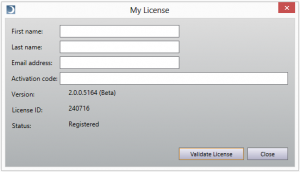
Copy and paste the your activation code into the Activation Code field then click the Validate License button.
The Wizard will contact the license server to verify your activation code. When it finishes the SitNGo Wizard window should display your license status as “Registered” just below the ribbon bar.
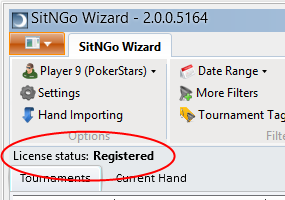
[h1]Troubleshooting[/h1]
If your activation fails:
1. Make sure your computer’s system clock is set to the correct date.
2. Make sure your fire wall or virus software is not blocking the Wizard’s access to the internet.
Then repeat the above instructions.
If you still have a problem send your license ID, which you can find in the My License dialog, to support@sngwiz.com
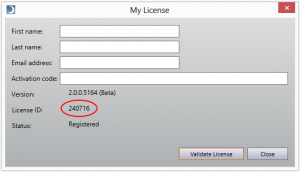
SitNGo Wizard 2 - Introduction
[h1]Introduction[/h1] The SitNGo Wizard 2 (SW2) is the most advanced tournament analysis tool available. SW2 is based on the Holdem Manager 2 (HM2) database engine, which provides several advantages.
- Hand histories are only imported once and stored in the HM2 database. All hand histories that have been imported are available to you at any time.
- You can select and analyze hands from multiple tournaments at a time.
- You can filter tournaments by date and tournament type,
- You can filter hands by game status, which allows you to see only hands where the Wizard thinks you may have made a mistake.
- Hands can be replayed with the full featured HM2 replayer.
If you are an HM2 user, the Wizard work exactly the same except a few more advanced features are available to you.
The SW2 window has a ribbon bar at the top and two tabbed view below.
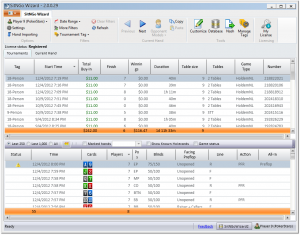
The SW2 window (click to enlarge).
[h1]The Ribbon Bar[/h1] The ribbon bar provides access to the most common Wizard commands.

The ribbon bar (click to enlarge).
The ribbon bar is organized into groups: Options, Filters, Current Hand, Tools, and Licensing.
[h1]Options[/h1] The Options group has 3 commands.

The Options group.
- Current player – This is usually your player name, but you can select different players to analyze hands from their perspective.
- Settings – Provides access to settings.
- Hand Importing – You can select files or folders to import.

Date range – Filter by any date range, such as today, last month, or set a custom date range.
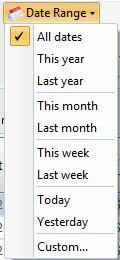 \
\Date range filter.
More filters – These are advanced HM2 filters only available in the HM2 integrated version.
Tournament Tag – You can filter by tournament type.
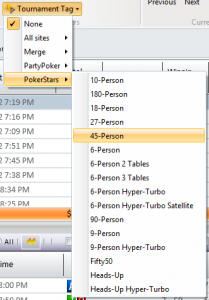
Tournament tags filter (click to enlarge).
The Clear Filters command clears all currently applied filters. The Refresh command refreshes and reapplies all current filters.
[h1]Current Hand[/h1] The Current Hand group commands either change the current hand or operate on the current hand.

The current hand group.
The previous and next button allow you to analyze different hands without needing to return to the tournaments view.
The Opponent Models command lets you assign an opponent model to each opponent.
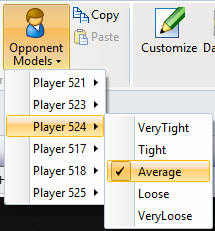
The opponent models command.
The Copy command copies the current hand history text to the clipboard.
[h1]Tools[/h1] The Tools group provides advanced commands.

The tools group.
The customize command allows you to customize the current hand or create a completely new hand from scratch.
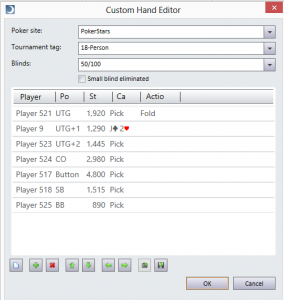
The customize hand editor (click to enlarge).
The database command let’s you create a new database or switch to a different database.
The Nash command sends the current hand to an online Nash analyzer.
You can use the manage tags command to create tags for tournament types that are not already supported. Tournament tags defined the tournaments blind structure and payouts, and all you can specify match criteria so that the tags will automatically be associated with the correct tournament hands.
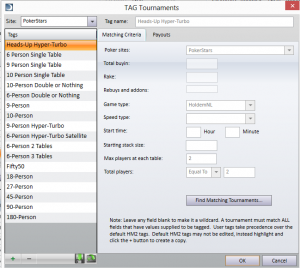
The tournament tags editor (click to enlarge).
[h1]Licensing[/h1] The Licensing group has only one command

The licensing group.
The My License command allows you to check your license status and enter your activation code when you purchase a license.
[h1]The Tournaments View[/h1] The tournaments view displays a list of your imported tournaments and hands.

The tournaments view (click to enlarge).
[h1]Tournaments List[/h1] The tournaments list is a grid of your tournaments, one row per tournament. You can filter which tournaments are displayed by using the filter group commands in the ribbon bar. You can sort the tournaments on any column by clicking the header of the column you wish to sort by.
[h1]Hands List[/h1] The hands list displays the hands associated with the tournaments that are selected in the tournaments list. Like the tournaments list, you can click on any column header to sort the list. [h3]The Game Status[/h3] The first column displays the game status of each hand. The game status represents a quick analysis of the hand with an icon that
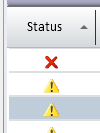
The game status column.
A green check mark indicates the hand was played correctly. A red circle with a white “X” indicates that the hand may have been played incorrectly. A yellow triangle indicates that it was a close decision. Hands to have no icon are hands where your effective stack size is greater than 10 big blinds.
You can filter on the game status to display, for example, only hands that are likely errors. In the toolbar at the top of the hands list click on the Game status check box to activate the game status combo box.

The game status check box.
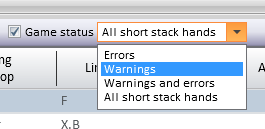
The game status combo box.
The Current Hand View
Select the Current Hand tab to analyze the currently selected hand.
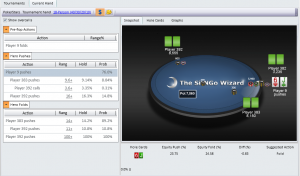
The current hand view (click to enlarge).
The current hand view has a toolbar to the top, an opponents action list on the left, and a snapshot and analysis summary on the right.
[h1]The Tool Bar[/h1] The current hand tool bar allows you to select a tournament tag for the hand and switch between final table (ICM) mode and chip equity mode.

The current hand tool bar (click to enlarge).
Click on the blue underlined link to select a different tournament tag (with its associated payouts).
Click on the $ icon to select final table (ICM) mode. Click on the chips icon to select chip equity mode.
[h1]Opponent Actions List[/h1] The opponent actions list displays pre-flop opponent actions, possible opponent actions after you push (Hero Pushes), and possible opponent actions when you fold (Hero Folds).
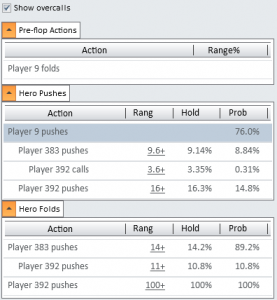
The opponent actions list (click to enlarge).
Selecting an opponent action row will update the snapshot view (see below) to reflect the state of the hand for that opponent action.
Click on the underlined Range value to change the opponent’s call range.
[h1]Snapshot View[/h1] The snapshot view displays the state of the hand for the currently selected opponent action.
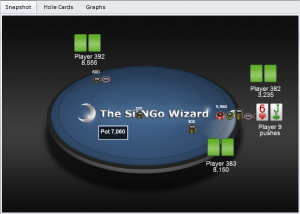
The snapshot view (click to enlarge).
[h1]Analysis Summary[/h1] The analysis summary shows your hole cards, your equity when you push, your equity when you fold, the difference between your equity push and equity fold, and the suggested action you should take.

The analysis summary (click to enlarge).
[h1]Hole Cards Grid[/h1] Select the Hole Cards tab to view the hole cards grid.
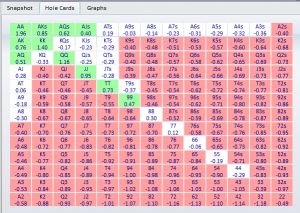
The hole cards grid (click to enlarge).
The hole cards grid show each possible hero hand in a color coded grid. Green hands are hands you should push, red hands are hands you should fold, and white hands are close to neutral. Each hand also displays the computed Diff value.
[h1]Opponent actions graph[/h1] The opponent actions graph plots an opponents hand range against your Diff value for the selected opponent action.
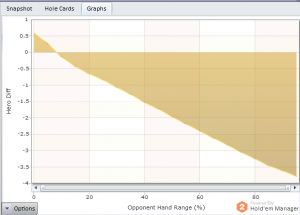
The opponent actions graph (click to enlarge).
Hand ranges with positive Diff values are the ranges you can profitably push against this opponent. You should fold your hand if you think your opponents hand range has a negative Diff value.
Downloading SNG Wizard
[h1]SNG Wizard Download[/h1]
Click here to download the stand alone version of SitNGo Wizard 2.
If you have Holdem Manager 2, the Wizard is already included in HM2. Just open HM2 and go to the SNG Wizard 2 Tab
Importing Hand Histories to SNG Wizard
[h1]Importing Hands into SNG Wizard[/h1]
Click the “Hand Importing” button on the ribbon bar to import hand histories into the Wizard.
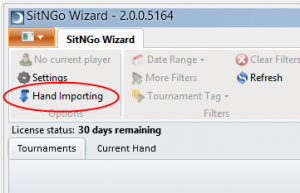
The Hand Importing button.
In the Hand Importing dialog, click “Import Hands” to select hand history files to import or click “Import Folder” to import all of the files in a folder.
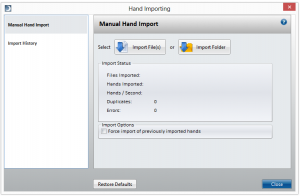
The Hand Importing dialog.
The dialog will display the progress as hands are imported.
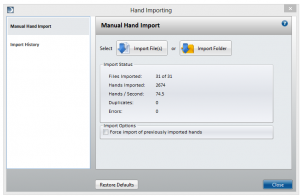
Hands imported successfully.
When the import is complete, click the Close button to return to the Tournaments view.
Analyzing a hand
[h1]Analyze hands Overview[/h1]
This section provides a quick overview of analyzing a hand in the Wizard. After you have imported some tournament hand histories you will see the tournaments view populated with your tournaments.
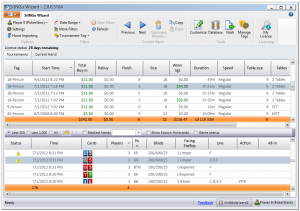
The Tournaments View.
At the top of the Wizard window is the ribbon bar. The ribbon bar provides access to commands for settings, filtering, navigation, and more. Just below the ribbon bar you will see two tabs: Tournements and Current Hand. The Tournaments tab displays a list of your tournaments and below that a list of hands that are in the selected tournaments. The Current Hand tab displays the analysis of the currently selected hand in the tournaments view. To analyze a hand, select the hand in the tournaments view and click on the Current Hand tab.
[h1]Current Hand[/h1]
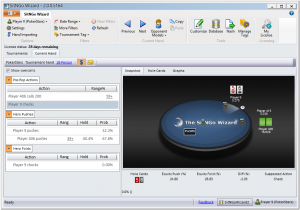
The Current Hand View.
The current hand view has three components: a toolbar at the top, the opponent actions list on the left side, the hand details view on the right side. The toolbar lets you quickly select a tournament tag, which defines tournament information like payouts. You can also switch between the final table (which uses ICM equity) and before the final table (which uses chip equity).
The opponent actions list displays all possible opponent actions. It is divided into three sections: previous opponent actions that occurred before the hero’s first action, possible opponent action that occur after the hero pushes, and possible opponent actions that occur after the hero folds. The right view displays tabs that show various details about the hand. The Snapshot tab shows a graphical snap shot of the state of the table depending on the currently selected opponent action. When you select a different opponent action, the snap shot will change. Below the snap shot is the analysis summary.
Equity Push is your equity when you push. Equity Fold is your equity when you fold. Diff is the difference between Equity Push and Equity Fold. When Equity Push is greater than Equity Fold (Diff is positive), pushing is more profitable than folding. When Equity Push is less than Equity Fold (Diff is negative), pushing is less profitable than folding. Selecting the Hole Cards tab will display the hole cards grid.
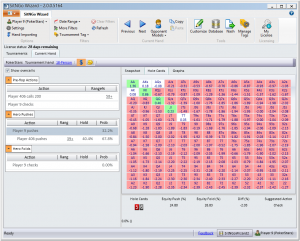
The hole cards grid.
The hole cards grid shows the Diff for every possible hero hand. Pushing hands are displayed in green. Folding hands are displayed in red. Neutral hands are displayed in white. Select the Graphs tab to display a graph of the currently selected opponent action.
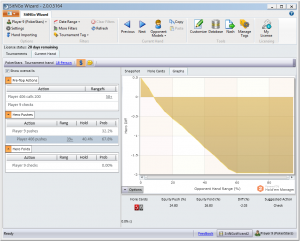
The opponent action graph.
The opponent action graph plots the select opponent action hand range against the hero’s Diff. The opponent hand range is plotted on the X axis and the hero’s Diff is plotted on the Y axis. This allows you to quickly visualize the range of the opponent’s action that you can profitably push against.
Current Hand View - Toolbar
[h1]Toolbar[/h1]
The current hand toolbar displays information about the current hand and allows you to change the hands payout structure.
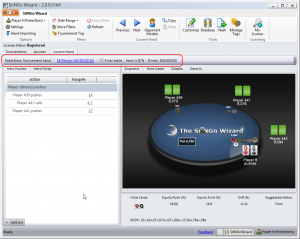
The current hand toolbar (click to enlarge).
[h1]The Poker Site[/h1]
The first item on the toolbar is the Poker Site where the hand was played.

The poker site (click to enlarge).
[h1]The Hand Source[/h1]
The second item is the source of the hand. This can be either:
- Tournament – The hand came from a tournament hand history.
- Custom – A custom hand created by you using the Customize ribbon button.
- Quiz – The hand was generated in quiz mode using the current quiz settings.

The hand source (click to enlarge).
[h1]The Tournament Tag[/h1] This item displays the tournament tag that is assigned to the current hand. The tournament tag defines the payout structure so it is very important that you use the correct tag when analyzing a hand.

The tournament tag (click to enlarge).
You can assign a different tag to the hand by clicking on the underlined tournament tag name.
[h1]The Is Final Table Check Box[/h1] Check the is final table check box if the current hand is at the final table. Uncheck it if there are still other tables active.

Is final table check box (click to enlarge).
When you are at the final table, the Wizard will calculate equity based on the tournament tag’s payout structure (using either ICM or the Roberts equity model). A payout based equity model can only be computed if all player stack sizes are known. If more than one table is still active, the player stack sizes at the other tables are not known.
When you are not at the final table, the Wizard uses chip equity mode. Chip equity mode ignores the payouts and gives each chip equal value.
[h1]Hero Position[/h1] The hero position is displayed on the toolbar. This field is not editable.

The hero position (click to enlarge).
[h1]Current Blinds[/h1] The current blinds are displayed on the toolbar. This field is not editable.

The current blinds (click to enlarge).
Current Hand View - Opponents Action
[h1]Opponents Action[/h1]
The opponent actions view in the current hand tab allows you to set the hand ranges for every possible opponent action. While default opponent hand ranges are provided, you should always review every opponent hand range and change those you feel are not accurate.
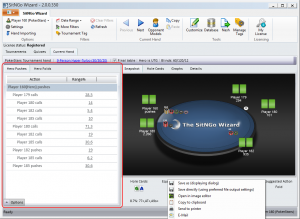
Opponent Actions View (click to enlarge).
When you select an action in the opponent actions view, most of the tabs in the details view on the right side are updated to reflect the currently selected action.
There are two tabs in the opponent actions view: Hero Pushes and Hero Folds.
[h1]Hero Push Actions[/h1]
The Hero Pushes tab displays opponent actions that can happen if the hero pushes all-in.
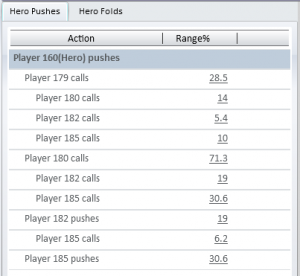
Hero push actions.
The first action is the hero’s push. The rest of the actions are opponent actions. There are two levels of opponent actions: call actions and overcall actions.
Call actions happen when the opponent is the first opponent to call the hero’s push. These actions are indented one level from the hero push action.
Overcall actions happen when an opponent calls both the hero and another opponent’s push. These actions are indented two levels. Overcall actions are only displayed when the Show Overcalls check box at the top of the view is checked.
[h1]Hero Fold Actions[/h1]
The Hero Folds tab displays opponent actions that can happen if the hero folds.
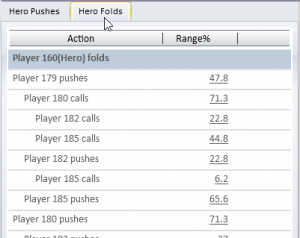
Hero fold actions.
There are three levels of opponent actions: push actions, call actions and overcall actions.
Push actions happen when the opponent is the first to push after the hero folds. These actions are not indented.
Call actions happen when the opponent is the first opponent to call an opponent’s push.
These actions are indented one level. Overcall actions happen when an opponent calls both an opponent’s push and another opponent’s call. These actions are indented two levels. Overcall actions are only displayed when the Show Overcalls check box at the top of the view is checked.
[h1]Editing Opponent Hand Ranges[/h1]
Clicking on an underlined opponent hand range will pop up the opponent hand range editor.
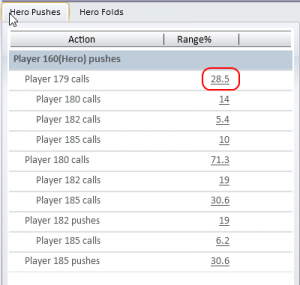
Click on an opponent hand range to edit it.
See Editing Opponent Hand Ranges for more information on the opponent hand range editor.
[h1]Opponent Actions View Settings[/h1]
Click on the Options button in the lower left corner of the opponent actions view to display the view settings.

Opponent actions view settings.
The settings allow you to control what opponent actions are displayed in the view.
- Show overcalls – When selected, opponent overcalls are shown. An overcall is when an opponent calls 2 previous all-in players.
- Show pre-hero folds – When selected, the view will show opponent folds that occur before the hero acts. Pre-hero actions other than folds are always displayed.
Current Hand View - Main View
[h1]Main View[/h1]
The current hand main view consists of four tabs in the upper right of the current hand view.
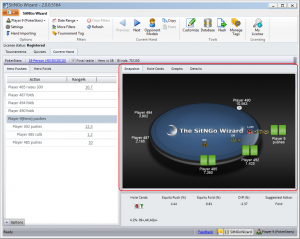
The current hand main view (click to enlarge).
[h1]The Snapshot[/h1]
The snapshot tab displays graphical table view of the selected action in the opponent actions view.
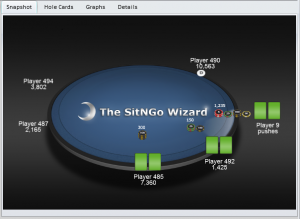
The snapshot.
When you select a different action in the opponents action view, the snapshot will update to reflect that action.
[h1]Hole Cards[/h1]
The hole cards tab show a grid of possible starting hole cards.
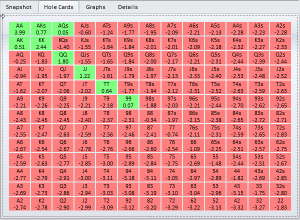
The hero hole cards.
Hole cards displayed in green are hands you should push. Hole cards in red are hands you should fold. Each cell displays the Diff (equity push – equity fold) for the hand.
The hole cards tab is the only tab that does not depend on the selected opponent action.
[h1]Graphs[/h1]
The graphs tab diplays a graph of the selected opponent action (in the opponent actions view). You can select which graph to display by clicking on the Options menu at the lower left corner of the graph.

Hero diff versus opponent hand range graph.
The diff versus opponent hand range graph displays an opponent’s hand range plotted against the Diff% value for the hero’s hole cards. When computing the Diffs for a particular opponent hand range, all other opponent hand ranges are held constant to whatever value is set in the game view. Only the selected opponent hand range is varied.
[h1]Details.[/h1]
The details tab shows detailed information about the selected opponent action (in the opponent actions view).
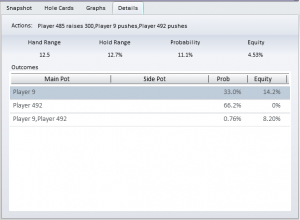
Details view.
[h2]Actions[/h2]
At the top of the view is a description of all actions before and including the selected action.
[h2]Action Properties[/h2]
The next section displays some general properties of the selected action.
- Hand range – The opponent’s hand range.
- Hold range – Tthe percentage of time your opponent actually picks up a hand in his calling range after removing the hero’s hole cards.
- Probability – The probability that this action will happen.
- Equity – The hero’s total equity for this action.
- Main pot – The winner (or winners in the case of a tie) of the main pot.
- Side pot – The winner (or winners in the case of a tie) of the side pot. If this field is blank, there is no side pot.
- Prob – The probability of the outcome happening.
- Equity – The hero’s equity for this outcome.
Current Hand View - Analysis Summary
[h1]Analysis Summary[/h1]
The analysis summary view is located in the lower right corner of the current hand view.
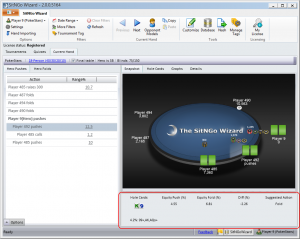
The analysis summary (click to enlarge).
It displays a summary of the analysis using the currently selected hero hole cards.

The analysis summary (click to enlarge).
The fields displayed are:
- Hole Cards – The currently selected hero hole cards. You can change the hero’s hole cards by opening the hero hole cards grid in the main view and clicking on a hand in the grid.
- Equity Push – Your equity when you push. This is the number that the SitNGo Wizard calculates when it considers all the possible outcomes when you push all-in. If you are at the final table, equity units are a percentage of the prize pool. Otherwise, equity units are in chips.
- Equity Fold – Your equity when you fold. This is the number that the SitNGo Wizard calculates when it considers all the possible outcomes when you fold. If you are at the final table, equity units are a percentage of the prize pool. Otherwise, equity units are in chips.
- Diff – The difference between Equity Push and Equity Fold.
- Suggested Action – The SitNGo Wizard’s suggested action. If the Diff% is greater than the Edge%, the suggestion is to Push or Call. Otherwise, the suggestion is to Fold.
Below these fields is a description of the range of hands that you can correctly play with the given conditions. It is expressed as a percentage of hands followed by a description of the actual hole cards you can play.

